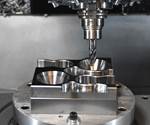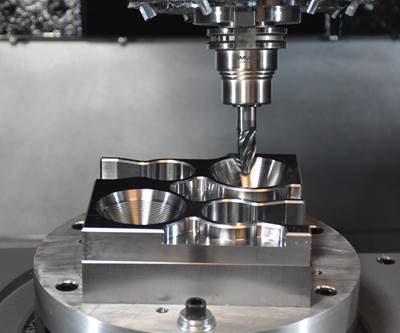Leveraging CAD/CAM Advances
Often-overlooked software tools can enhance moldmaking business competitiveness.
Mold builders have experienced difficult times as inexpensive labor enticed customers to look offshore in search of bargain pricing. This trend persisted even though many of these shoppers frequently paid hidden costs in terms of communications barriers, quality and leadtime challenges. In recent years, many of these issues have been resolved for manufacturers and U.S. mold builders who have established their own presence in distant locations.
As time has passed, many of these distant suppliers have seen their own labor costs rise and the demand for higher quality increase. This has started to level the playing field to the point where North American mold builders and their customers are willing, once again, to factor the value of shorter leadtimes, reduced shipping costs and closer communications between designers and moldmaking engineers into their purchasing decisions.
To stay in the game, mold builders everywhere must maximize the performance of their critical, skilled workforce and CNC equipment resources. Good CAD/CAM systems provide a surprising number of tools that can help mold builders do both. They provide so many, in fact, that busy users may lose sight of them. Check out this list of commonly overlooked features to ensure that your shop is getting the most from its CAD/CAM software.
Constant Chip Load Machining
Conventional roughing approaches back off on material removal rates to compensate for an anticipated worst-case condition, such as burying a cutting tool in a corner. Feeds and speeds are reduced to accommodate this possible event with a little extra added just to be safe. With today’s advanced cutting tools and toolpaths, this approach is unnecessary and harmful as it saps productivity.
The better alternative is to employ toolpaths that rely on material-aware algorithms to maintain a constant, ideal chip load as defined by the cutting tool manufacturer throughout the entire roughing operation. This is achieved by the toolpath automatically adjusting its trajectory and motion based on feed per tooth specifications and the remaining material ahead of the tool.
As a result, tool burial is avoided no matter how complex the geometry. Material can potentially be removed as aggressively as the CNC machine will allow without the user worrying about exceeding the tool’s cutting capabilities, which can result in tool breakage or part or machine damage. Mold builders who have adopted this approach report a range of advantages that include material removal rate improvements of 25 to 70 percent or more, reduced tool wear, improved productivity and a reduction in overall cycle time. This machining strategy can also safely accelerate both the programming and CNC manufacturing efficiency for the machining of electrodes.
Mold builders who use contemporary toolpath strategies that maintain a consistent chip thickness report a substantial positive impact on leadtimes and operating costs. This cutting strategy is one of the easiest things a mold shop can do to become more competitive.
Better Finishing Strategies
Machine tool builders, cutting tool vendors and CAD/CAM software developers are continually challenging each other with new solutions that require each to constantly improve their own products. For example, some of the super-hard materials that are sometimes used in moldmaking spurred cutting tool makers to develop advanced tool coatings, materials and geometries that would provide ultra-efficient cutting. This led to the expansion of constant chip load cutting strategies, so that these tools can be used effectively.
Now, a similar evolution is happening in the realm of finishing. New finishing toolpaths are in development to effectively drive new “shaped” cutting tools with cutting radii many times greater than conventional ball end mills. The toolpath’s mission is to orient the tool to the part, allowing it to finish much larger areas per pass, while producing a better finish with fewer and shallower cusps. This emerging technology is not applicable to every mold surface. However, mold builders have realized up to 80 percent improvement in surface finish cycles on projects where they have used these new cutting tools.
Faster Production
In some shops, the starting point for generating a part program comes after the CAD file is imported from a dedicated CAD system into the CAM environment. In this case, it is important to ensure that the CAM software can cleanly import CAD files, regardless of the source. Oftentimes, additional CAD work is required to prepare the CAD file for efficient CNC programming.
Rather than continuously reverting to the model to make iterative changes required for best CAM practices, it can be far less time-consuming to use resident CAD for CAM capabilities within the CAM software itself. This ensures that the production process moves continuously forward. For example, sophisticated repair algorithms make it possible to fix sketchy surfaces, particularly where the initial data came from a scanned physical model. Features like push/pull or direct modeling enable changes such as changing fillet sizes, moving or editing features or temporarily filling in holes so they can be machined properly, even if the model does not have an associated history tree.
Another attractive alternative for getting mold components on the CNC machine faster is to move the mold design process forward into an integrated CAD/CAM environment with moldmaking-specific functionalities. Examples include parting line separation, cavity splitting, templates for mold plates and electrode creation.
Mold builders can be more competitive when they implement a combination of digital tools that make the process of moving from design to CNC manufacturing as seamless as possible so that the model does not become a roadblock on the path to customer satisfaction.
Incremental Advancements
Some improvements that are introduced with each CAD/CAM software release are incremental. New features and tools from these releases are not always easily noticeable. However, improved functionality from these features can offer big advantages to shops that have limited time to identify and implement them. A great example of this is simulation, which has become increasingly accurate and inclusive. Today’s CAM simulation incorporates machine-specific kinematics so that the image on the screen is a much more accurate reflection of the toolholder, workholding solution and all machine axes (and not just how a tool will behave). Great simulation empowers a mold builder to use newer and more innovative machining strategies.
Toolpath smoothing is another example of ongoing incremental improvements that can result in improved workpiece production. The algorithms governing some of the latest 3D multi-surface finishing toolpaths can now smooth out angular changes where different cutting strategies intersect. This results in a better, smoother finish and reduces the extent of bench work required at the end of the mold manufacturing process.
Other features of CAM software that moldmakers should investigate are the management tools incorporated within the software. Examples include an operations manager that allows programmers to easily save and then access effective machining strategies for similar parts. These types of tools allow experienced users to store hard-won proprietary knowledge that can be used on their own, and these types of tools enable coworkers to build competitiveness on the foundation of previous successes.
CAD/CAM software developers spend thousands of hours maintaining and updating their product offerings. Chances are there will be some things in the next release of your CAD/CAM software that can make your shop more competitive.
Related Content
How a Small Programming Change Cuts Cycle Time in Half
Overriding the CAM system when milling a series of lifter pockets helps to improve metal removal rate and increase feed rates.
Read MoreHow to Analyze and Optimize Cutting Conditions to Reduce Cycle Time
Plastic injection mold design and manufacturing company puts NC program optimization software module to the test. The results were surprising.
Read MoreTips for Tackling Mold Design, Machining, Cutting Tool and Wear Challenges
Tips for tasks ranging from reducing risk in part design and taking advantage of five-axis machining to refining cutting tool performance and reducing wear with guiding and centering systems.
Read MoreMold Design Review: The Complete Checklist
Gerardo (Jerry) Miranda III, former global tooling manager for Oakley sunglasses, reshares his complete mold design checklist, an essential part of the product time and cost-to-market process.
Read MoreRead Next
A Strategy for Better Mold Finishes
Combining advanced tool geometry and complementary CAM tool paths can reduce finish cycle times and improve surface quality.
Read MoreAre You a Moldmaker Considering 3D Printing? Consider the 3D Printing Workshop at NPE2024
Presentations will cover 3D printing for mold tooling, material innovation, product development, bridge production and full-scale, high-volume additive manufacturing.
Read MoreHow to Use Strategic Planning Tools, Data to Manage the Human Side of Business
Q&A with Marion Wells, MMT EAB member and founder of Human Asset Management.
Read More





















